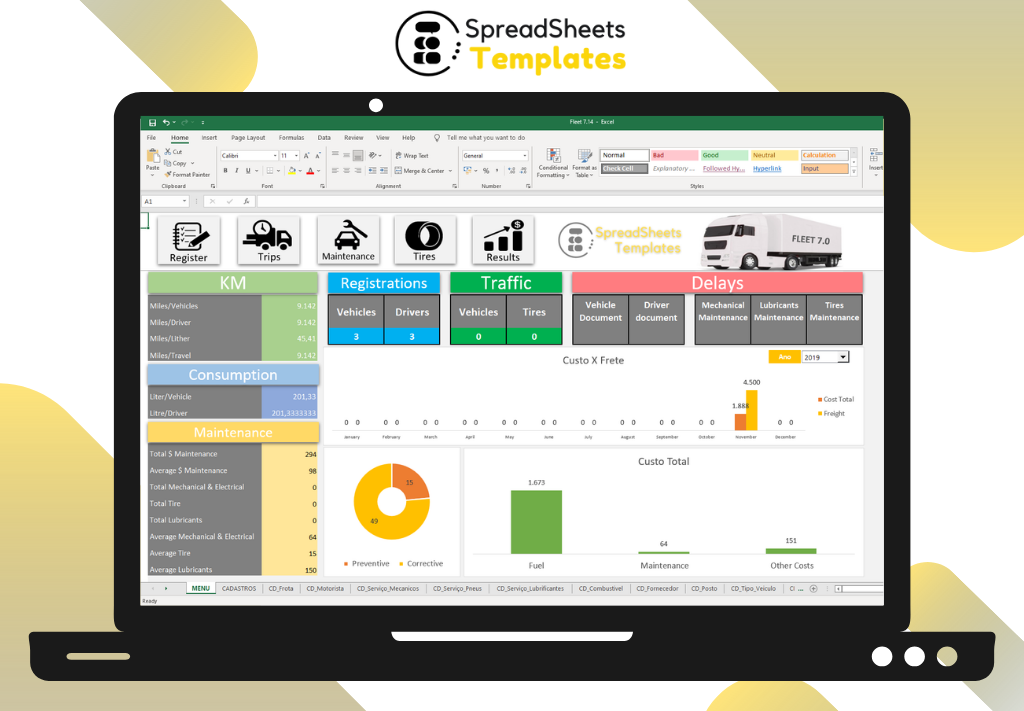Fleet Control Worksheet Leave a comment
Streamline Your Fleet Management Efforts
Introduction
In the fast-paced world of fleet management, staying organized and efficient is crucial for success. Whether you’re managing a small fleet of vehicles or overseeing a large-scale operation, having a robust system in place is essential. This is where a Fleet Control Worksheet comes into play. This comprehensive tool provides a structured approach to managing various aspects of fleet operations, from vehicle maintenance and fuel consumption to driver assignments and scheduling. In this article, we’ll explore the benefits of using a Fleet Control Worksheet and how it can help streamline your fleet management efforts.
Fleet Control Worksheet: A Holistic Approach to Fleet Management
What is a Fleet Control Worksheet?
A Fleet Control Worksheet is a dynamic document that serves as a centralized hub for all fleet-related information. It is designed to capture and organize essential data points, allowing fleet managers to gain valuable insights and make informed decisions. This worksheet acts as a comprehensive repository for key details such as vehicle information, maintenance records, fuel consumption, driver assignments, and more. By having a single source of truth, fleet managers can easily monitor and analyze various aspects of their fleet’s performance.
The Importance of Fleet Control Worksheet in Fleet Management
Efficient fleet management involves juggling multiple variables, such as vehicle maintenance, driver assignments, fuel consumption, and compliance with regulations. Without a structured system in place, these tasks can quickly become overwhelming. Here’s why a Fleet Control Worksheet is crucial for effective fleet management:
- Streamline Vehicle Maintenance: Regular maintenance is essential to keep vehicles in optimal condition and minimize downtime. With a Fleet Control Worksheet, you can schedule routine maintenance tasks, track service history, and receive reminders for upcoming services. This proactive approach ensures that your fleet operates smoothly and reduces the risk of unexpected breakdowns.
- Monitor Fuel Consumption: Fuel expenses constitute a significant portion of a fleet’s operating costs. A Fleet Control Worksheet allows you to track fuel consumption for individual vehicles, identify patterns, and implement measures to improve fuel efficiency. By analyzing this data, you can identify fuel-wasting trends and take corrective actions, such as driver training or adopting fuel-saving technologies.
- Optimize Driver Assignments: Assigning the right driver to the right vehicle is crucial for operational efficiency and customer satisfaction. A Fleet Control Worksheet enables you to keep track of driver assignments, monitor driver performance, and ensure compliance with regulatory requirements. With real-time visibility into driver availability and qualifications, you can make informed decisions when allocating resources.
- Enhance Compliance and Safety: Compliance with regulatory standards and safety protocols is paramount in fleet management. A Fleet Control Worksheet helps you maintain accurate records of vehicle inspections, licenses, permits, and certifications. By staying on top of compliance requirements, you can minimize legal risks and ensure the safety of your drivers and vehicles.
- Improve Cost Management: Effective cost management is a top priority for fleet managers. A Fleet Control Worksheet allows you to monitor expenses related to vehicle maintenance, repairs, fuel consumption, and other operational aspects. By identifying cost-saving opportunities and implementing efficient processes, you can optimize your fleet’s financial performance.
Fleet Control Worksheet Implementation and Best Practices
Implementing a Fleet Control Worksheet
Implementing a Fleet Control Worksheet requires careful planning and consideration. Here are the steps to get started:
- Identify Key Data Points: Determine the critical data points you want to capture in your Fleet Control Worksheet. This may include vehicle details, maintenance records, fuel consumption, driver information, and any other relevant metrics specific to your fleet.
- Choose a Suitable Format: Decide whether you want to create a digital Fleet Control Worksheet using a spreadsheet application like Microsoft Excel or utilize a dedicated fleet management software that offers built-in worksheet functionalities. Consider the size of your fleet and the complexity of your operations when making this decision.
- Design the Worksheet: Structure your worksheet in a logical and intuitive manner. Organize different sections for vehicle information, maintenance records, fuel consumption, driver assignments, and other relevant categories. Ensure that the layout is user-friendly and allows for easy data entry and retrieval.
- Train Fleet Personnel: Introduce the Fleet Control Worksheet to your fleet personnel and provide training on how to use it effectively. Emphasize the importance of accurate data entry, timely updates, and adherence to established processes. Encourage feedback from the team to continually improve the worksheet’s usability.
- Monitor and Refine: Regularly review the data entered into the Fleet Control Worksheet and identify areas for improvement. Keep an eye on data accuracy, completeness, and consistency. Refine the worksheet as needed to accommodate evolving business requirements and feedback from users.
Best Practices for Fleet Control Worksheet Management
To maximize the benefits of using a Fleet Control Worksheet, consider the following best practices:
- Regular Data Updates: Encourage fleet personnel to update the worksheet in real-time or at predefined intervals. This ensures that the data remains accurate and up to date, enabling you to make informed decisions based on the latest information.
- Data Accuracy and Consistency: Emphasize the importance of accurate and consistent data entry. Implement validation checks and error alerts to minimize data discrepancies. Regularly audit the worksheet to identify and rectify any inaccuracies.
- Data Security and Access Control: Protect sensitive fleet data by implementing appropriate security measures. Restrict access to the Fleet Control Worksheet to authorized personnel only. Regularly back up the data to prevent loss due to unforeseen circumstances.
- Data Analysis and Reporting: Leverage the data captured in the Fleet Control Worksheet to generate reports and analytics. Utilize visualization tools and charts to identify trends, highlight performance metrics, and facilitate data-driven decision-making.
FAQs about Fleet Control Worksheet
Q1: How can a Fleet Control Worksheet help me improve vehicle maintenance? A1: A Fleet Control Worksheet allows you to schedule routine maintenance tasks, track service history, and receive reminders for upcoming services. By proactively managing maintenance, you can ensure vehicles stay in optimal condition and minimize unexpected breakdowns.
Q2: Can a Fleet Control Worksheet help reduce fuel expenses? A2: Yes, by tracking fuel consumption for individual vehicles and analyzing the data, you can identify fuel-wasting trends and take corrective actions. This may include driver training, adopting fuel-saving technologies, or optimizing routes to improve fuel efficiency.
Q3: Is it possible to monitor driver assignments using a Fleet Control Worksheet? A3: Absolutely! With a Fleet Control Worksheet, you can keep track of driver assignments, monitor driver performance, and ensure compliance with regulatory requirements. Real-time visibility into driver availability and qualifications helps you make informed decisions when allocating resources.
Q4: How does a Fleet Control Worksheet enhance compliance and safety? A4: A Fleet Control Worksheet enables you to maintain accurate records of vehicle inspections, licenses, permits, and certifications. By staying on top of compliance requirements, you can minimize legal risks and ensure the safety of your drivers and vehicles.
Q5: Can a Fleet Control Worksheet help optimize cost management? A5: Yes, a Fleet Control Worksheet allows you to monitor expenses related to vehicle maintenance, repairs, fuel consumption, and other operational aspects. By identifying cost-saving opportunities and implementing efficient processes, you can optimize your fleet’s financial performance.
Q6: Is it necessary to use specialized fleet management software for a Fleet Control Worksheet? A6: While specialized software can offer additional features and automation, you can also create a Fleet Control Worksheet using spreadsheet applications like Microsoft Excel. Choose the option that best suits the size and complexity of your fleet operations.
Conclusion
Efficient fleet management requires a structured and organized approach. A Fleet Control Worksheet serves as a valuable tool that centralizes fleet-related information, streamlines processes, and enables data-driven decision-making. By implementing a Fleet Control Worksheet and following best practices, you can optimize your fleet’s performance, enhance cost management, and ensure compliance with regulations. Embrace this holistic approach to fleet management and experience the benefits firsthand.


